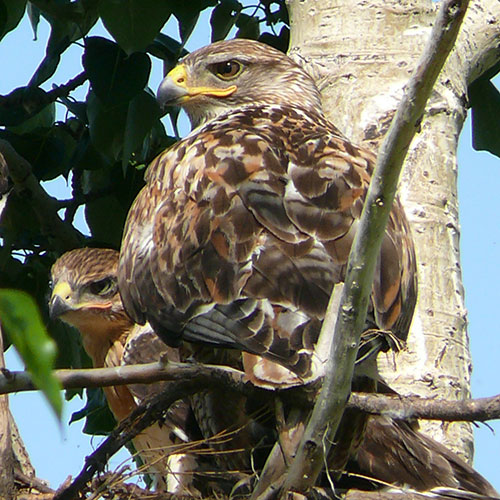Ferruginous Hawk Trail Cameras
2022 Nesting Season
We are very excited for the arrival of our ferruginous hawks this year! Thanks to AltaLink, an additional nesting pole and platform has been installed—now we have more cameras than ever before! With a total of three remote cameras keeping an eye on three different nests, we are going to capture more of the hawks' dramatic lives as they battle the elements, hunt for food, lay eggs, and raise their young.
Last season, we saw six young hawks fledge from the three nests. How many fledglings do you think we will see this year? This webpage will be updated regularly with images and information from each nest, so stay tuned and find out!

One of the biggest challenges for ferruginous hawks is the loss of suitable nesting habitat; from 1992 to 2005, the species declined by 64 per cent in Canada. The best thing we can do to bring the population back up is to provide nesting areas for them in suitable locations and then not disturb them.
Appearance
- An At Risk species in Alberta (around 865 pairs estimated in Alberta based on 2015 survey).
- Wingspan can reach 1.5 metres.
- Largest of North America’s hawks (63 cm long).
- Light-coloured, rusty back, light and unbanded tail (there is also a dark morph with rufous-brown feathers)
Habitat
- Migrate from southwest United States and Mexico.
- Prefer areas of uncultivated pastureland or prairie.
- Only one of two raptors to use grasslands as main habitat.
Food
- Mainly feeds on rodents (ground squirrels, mice, voles, white-tailed jackrabbits).
- One pair (with chicks) consumes an average of 480 ground squirrels per season.
- Hunt during the day when squirrels are active.
Timeline
- Arrive in Alberta in early to mid March.
- Nest and raise chicks from mid-April to late-July.
- Migrate south in September and October.
Courtship
- Mainly monogamous.
- Meet and perform dancing routine in the sky. Finally, the pair grasps beaks and talons and spirals downwards.
Breeding
- Birds return to the same area (often the same nest).
- New sticks and twigs are added to existing nest each year.
- Historically, they used bison bones and dung.
- Nests can be found from ground level to 20 metres high (cliffs, haystacks, farm buildings, trees).
- May have up to five nests but only use one each year.
- They lay three to five eggs each year.
Lifespan
- Incubation is 32-36 days.
- Attempt flight at about two months.
- Mature at three years of age.
- Live to 15 or 20 in the wild.
MULTISAR = Multiple Species at Risk
MULTISAR works with many partners to conserve Species at Risk in Alberta’s native grasslands through habitat stewardship. Aside from the ferruginous hawks, there are many other at-risk grasslands species that their work helps to conserve, while also providing a host of benefits to landholders. If you or someone you know manages land in Alberta’s grassland, have a look at what they do here.
For further reading, check out Species at Risk Conservation Stories or find more Species at Risk publications and resources.


